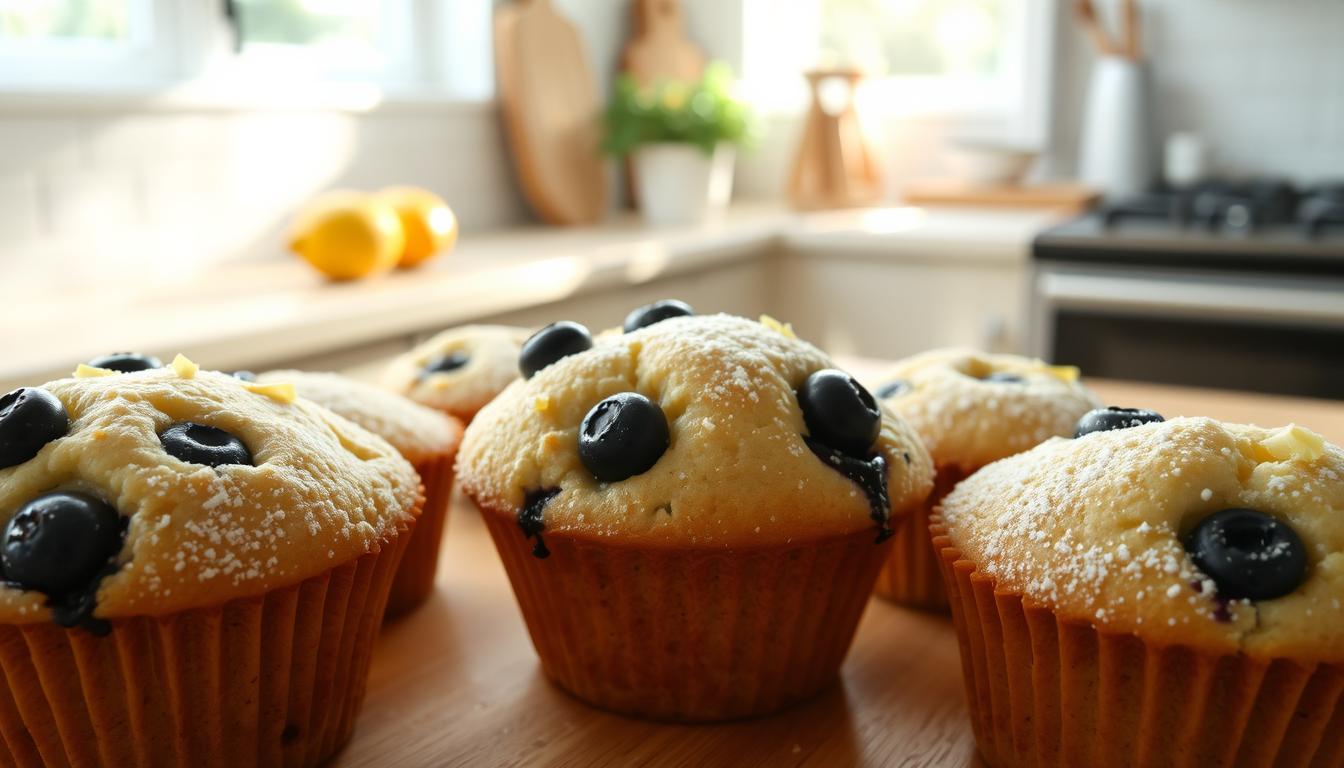Vegan Lemon and Blueberry Muffins offer a bright, bakery-style breakfast with no dairy or eggs.
What if one simple muffin could prove plant-based baking is just as tender and tall as the real thing?
You’ll find a clear muffin recipe that uses pantry ingredients like flour, plant milk, and simple swaps such as applesauce to go oil-free or a GF blend when needed.
Keep ingredients at room temperature and aim for a thick batter to get tall domes. Start hot in the oven, then lower the heat to finish baking evenly.
Practical tips include filling liners nearly to the top, testing doneness with a toothpick, and cooling briefly in the pan before moving to a rack for the best texture.
Key Takeaways
- Use room-temperature ingredients and a thick batter for taller muffins.
- Simple pantry swaps let you make this muffin recipe oil-free or gluten-free.
- Start with high heat, then reduce to improve rise and bake evenly.
- Choose bone-char-free sugar and plant milk to keep this bake fully plant-based.
- Test with a toothpick and cool briefly in the pan before transferring to a rack.
Vegan Lemon and Blueberry Muffins that brighten your morning
These muffins are an easy way to add citrus and fruit to your breakfast without fuss. You’ll love how quick the mix comes together and how reliably fluffy each batch bakes.
Why this muffin belongs in your rotation
- They work with pantry ingredients and a fast one-bowl method, so you save time on busy mornings.
- Making a simple plant “buttermilk” by stirring lemon juice into almond milk keeps the crumb tender without dairy.
- Coating berries in a touch of cornstarch helps prevent sinking and keeps the batter from turning streaky.
What makes the citrus + berry pairing pop
Lemon zest and lemon juice lift sweetness and sharpen the fruit flavors. Rubbing the zest into sugar releases oils for extra aroma.
Fresh blueberries give clean bursts of flavor, while frozen berries make this recipe year-round friendly. Tossing them in cornstarch before folding into the batter helps them distribute evenly.
| Feature | Fresh blueberries | Frozen berries |
|---|---|---|
| Texture | Firm pops of fruit | Softer, juicier after baking |
| Prep tip | Wash and dry before use | Do not thaw fully; fold in frozen |
| Bleeding risk | Low | Higher—coat with cornstarch |
Vegan Lemon and Blueberry Muffins: Key ingredients you’ll use
Before you mix, gather the staples that control texture and flavor. Use all-purpose flour or a GF 1:1 blend for the base, baking powder for lift, vegan sugar that isn’t processed with bone char (consult PETA’s list for guidance), and a small pinch of salt.
Dry ingredients
Flour, sugar, baking powder, and salt create structure without eggs. Rub lemon zest into the sugar to release oils before whisking it into the dry mix.
Wet ingredients
Use almond milk or oat milk for plant-based “milk” that curdles with lemon juice to mimic buttermilk. Add a neutral oil like canola or grapeseed for tender crumbs, or swap in extra unsweetened applesauce to go oil-free.
Fresh vs frozen fruit and finishing touches
Fresh blueberries give neat pops and less bleeding; frozen berries save time and money. You can thaw at room temperature or fold in frozen and add a minute or two to bake time.
- Stir vanilla into the wet mix for warmth.
- Keep a few berries to set aside for topping in the muffin tin.
- Line or grease the tin for clean release.
Step-by-step: Mix your muffin batter like a pro
Start smart: get your oven to 400°F and line the tin so the batter moves from bowl to heat without delay. An oven thermometer helps if you want consistent results.
Prep the muffin tin and preheat the oven for even baking
Make sure the liners are in place and the rack sits mid-oven. Preheating locks in lift from lemon juice reacting with milk and baking powder.
Build the batter: combine dry and wet ingredients without overmixing
In one bowl, whisk flour, sugar, baking powder, and salt until even. In a second bowl, whisk the wet ingredients—milk, oil, vanilla, and lemon juice—so they blend smoothly.
Slowly fold wet into dry and stop when the batter looks cohesive. Aim for a thick muffin batter that falls slowly from your spoon to keep the crumb tender.
Fold in berries and zest, then portion for tall domes
Gently fold in fresh blueberries and lemon zest with a spatula to avoid crushing the fruit. If using frozen fruit, add last and expect a few extra minutes of bake time.
- Portion nearly to the top of each liner with a large scoop for tall domes.
- Set aside a few berries to dot the tops for a bakery look.
- Bake at 400°F for 15-18 minutes or use a two-stage oven plan for extra rise.
| Step | Action | Why it matters |
|---|---|---|
| Preheat & prep | 400°F; line tin | Locks in rise and even bake |
| Dry mix | Whisk flour, sugar, powder | Even lift and structure |
| Wet mix | Combine milk, oil, vanilla, lemon juice | Activates leaveners; flavor |
| Fold & portion | Gently add blueberries, scoop high | Prevents sinking; creates tall muffins |
Oven strategy to bake muffins with sky-high domes

Heat control is the single best trick to turn good muffin batter into bakery-style domes. Start with a hot blast to set the exterior, then lower the heat so the crumb finishes tender.
Temperature cues: initial high heat, then reduce for a tender crumb
Two-stage timing works well: bake muffins at 400°F for 5 minutes, then drop to 350°F and finish for 15–20 minutes. If your oven runs hot, try 425°F then 375°F instead.
Filling every other cup in the tin can improve hot air flow and boost dome height. The initial heat expands steam and activates leaveners in the muffin batter for a strong lift.
How to test doneness and move to a cooling rack
Test doneness with a toothpick; it should come out clean or with a few moist crumbs, not wet batter. Tops should be golden and spring back lightly when touched.
Let muffins rest in the pan for 5–10 minutes, then transfer to a cooling rack so steam won’t sog the bottoms. Blueberry muffins made with frozen fruit may need an extra minute or two.
Tip: if your oven is inconsistent, use an oven thermometer (dofollow suggestion) to verify the temperature and adjust minutes accordingly.
Pro tips to make sure your vegan blueberry muffins stay fluffy
Bright, airy muffins start with careful temperature and gentle handling of ingredients. Small adjustments at the bench and in the oven give the biggest lift.
Room temperature ingredients and thick batter advantages
Bring plant milk, lemon juice, and other liquids to room temperature. This helps the batter emulsify and trap air for a loftier rise.
Make sure the muffin batter is thick. A loose batter causes berries to sink and can create gummy centers.
Coating berries, avoiding streaking, and keeping color
Lightly toss blueberries in a teaspoon of flour or cornstarch before folding in. This reduces color bleed and keeps crumbs pale, not purple.
Fold lemon zest and berries in at the end with just a few strokes to avoid toughening the crumb.
When to set aside extras and how to portion
Set aside a few berries to press on top for a bakery look. Use a large scoop for even portions so every muffin bakes the same.
Use fresh baking powder, test with a toothpick, then cool briefly in the pan and transfer to a cooling rack so steam can escape.
“The small step of bringing ingredients to room temperature often changes bake results more than any single recipe tweak.”
| Checkpoint | What to do | Why it matters |
|---|---|---|
| Ingredient temp | Bring to room temperature | Better emulsification and rise |
| Fruit prep | Coat berries in flour | Less streaking; even crumbs |
| Portioning | Use a large scoop | Uniform domes and bake time |
Flavor upgrades: streusel crumb or lemon glaze for bakery vibes

Add a crunchy, citrus-scented topping or a glossy drizzle to lift every bite. These finishing touches are fast and give your blueberry muffins a bakery look without much extra effort.
Quick lemon streusel with vegan butter and lemon zest
Rub the lemon zest into the sugar, then work in flour, a pinch of cinnamon, and softened vegan butter until the mix looks like damp sand.
Sprinkle the streusel over each muffin before baking. It bakes into a crunchy, aromatic top that contrasts the soft crumb.
Bright lemon glaze drizzle once muffins cool to room temperature
Whisk powdered sugar with lemon juice and a bit more zest until pourable. Drizzle only after muffins reach room temp so the glaze sets in minutes.
- Add a pinch of salt to balance sweetness.
- For oil-free bakers, swap chilled coconut oil for vegan butter.
- Mix in a few rolled oats to the streusel for extra crunch.
Diet-friendly swaps and variations you can set aside for next time
If you want fewer calories or no oil, you can make easy changes that keep the crumb tender and tall. Below are practical, tested swaps to fit allergies, reduce sugar, or go gluten-free without reworking the whole muffin recipe.
Oil-free and lower-sugar options
Go oil-free by replacing oil with unsweetened applesauce, mashed banana, or plain plant yogurt. Add a splash more milk so the batter stays scoopable and thick.
Lower sugar by using coconut sugar, allulose, or a touch of maple syrup. If you use maple, cut back slightly on milk so the batter doesn’t get too loose.
Gluten-free paths
For GF needs use a certified GF 1:1 flour blend or finely ground oat flour. Bob’s Red Mill GF 1-to-1 Baking Flour is a reliable choice: https://www.bobsredmill.com/products/gluten-free-1-to-1-baking-flour.html (dofollow).
Keep GF batters a bit thicker than wheat versions so they support berries and rise well.
Plant milk picks and add-ins
Choose plant milks that match your pantry: almond milk is light, oat milk is creamy, and soy milk adds protein. Use vanilla to boost flavor.
- Stir in cinnamon or fresh thyme for savory notes.
- Fold in up to 1/2 cup rolled oats or dark chocolate chips for texture.
- If using oat flour, blitz it fine to avoid density.
Equipment checklist for consistent results
Having a few dependable kitchen tools on hand keeps your baking consistent and stress-free. Gather simple gear you already own so setup is fast and predictable.
Basic items
- Use a sturdy 12-cup muffin tin with paper or silicone liners to prevent sticking and speed cleanup. A single nonstick tin helps if you bake often.
- Keep one large mixing bowl and a medium bowl for dry and wet steps. A balloon whisk and a flexible spatula help you mix without overworking the batter.
- A spring-loaded scoop portions batter evenly so every muffin rises to the same height; a measuring cup keeps volumes consistent.
Oven, cooling, and finishing tools
- Place the tin on the center rack for the most even heat transfer in the oven.
- Use a reliable cooling rack to let air circulate under baked goods, keeping bottoms from steaming.
- An accurate oven thermometer verifies your temperature, which matters for dome formation and crumb texture (dofollow).
- A fine zester and a small offset spatula finish tops cleanly when you add streusel or glaze.
Storage, freezing, and how to keep muffins fresh
How you stash leftover muffins affects texture more than the recipe. Let the batch rest briefly in the pan, then move each piece to a cooling rack so steam can escape. This step prevents soggy bottoms when you store them later.
Once the muffins cool completely, place them in an airtight container. At room temperature they stay fresh for 1–2 days in a cool, dry kitchen. In warm climates, refrigerate in an airtight container to keep them good for about 4–5 days.
For longer storage, wrap each muffin and freeze in an airtight container or freezer bag for up to 3 months. Oil-free versions can dry faster, so freeze those the same day you bake.
- When ready to eat, remove portions and thaw room temperature, keeping them covered so they don’t dry out.
- You can also thaw room overnight, then warm for a few minutes in a 300–325°F oven or toaster oven.
- Avoid long microwave bursts; short pulses are best to prevent a tough crumb.
| Storage method | Duration | Best use |
|---|---|---|
| Room temp in airtight container | 1–2 days | Quick snacks, same-week eating |
| Refrigerated in airtight container | 4–5 days | Warm climates or longer weekly use |
| Frozen, wrapped, airtight | Up to 3 months | Batch baking; thaw room temperature before reheating |
Conclusion
A final quick guide helps you turn this one-bowl method into a dependable weekly treat.
Focus on three things: measure carefully, keep the muffin batter thick, and use the hot-then-lower oven trick to bake muffins with tall domes and a tender crumb. Use almond milk or an oat alternative, fold berries gently, and portion the batter with a scoop so every cup in the muffin tin bakes evenly.
Store cooled muffins on a rack, then use an airtight container or freeze individually for longer life. For ethical sugar choices see PETA’s list (https://www.peta.org), grab Bob’s Red Mill GF 1-to-1 blend for gluten-free batches (https://www.bobsredmill.com), and find more plant-based ideas at Oh She Glows (https://ohsheglows.com).
Now go bake muffins—your next tray of vegan muffin joy is one bowl, one oven, and a little zest away.


